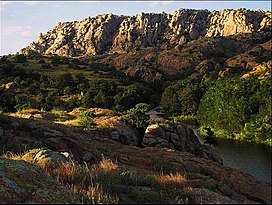| Wichita Mountains | |
|---|---|
 Elk Mountain, in the eastern Wichita Mountains | |
| Highest point | |
| Peak | Haley Peak (officially unnamed) |
| Elevation | 2,481 ft (756 m) |
| Coordinates | 34°50′22″N 98°48′13″W / 34.83944°N 98.80361°W |
| Dimensions | |
| Length | 60 mi (97 km) northwest-southeast |
| Width | 10 mi (16 km) |
| Geography | |
| Country | United States |
| State | Oklahoma |
| Geology | |
| Orogeny | Ouachita orogeny |
| Rock age(s) | Cambrian, Pennsylvanian, Permian |
| Rock type(s) | granite, rhyolite, gabbro, conglomerate |
The Wichita Mountains are located in the southwestern portion of the U.S. state of Oklahoma.[1] It is the principal relief system in the Southern Oklahoma Aulacogen, being the result of a failed continental rift. The mountains are a northwest-southeast trending series of rocky promontories, many capped by 500 million-year old granite. These were exposed and rounded by weathering during the Pennsylvanian and Permian Periods. The eastern end of the mountains offers 1,000 feet (305 m) of topographic relief in a region otherwise dominated by gently rolling grasslands.
The mountains are home to numerous working ranches and quarry operations, the state reformatory, recreational homes and campsites, and scenic parklands. Fort Sill, home of the U.S. Army Field Artillery School, occupies a large portion of the southeastern end of the mountains.
